Rapid Process Natural Bamboo into Outdoor Bamboo-Fiber-Reinforced Composite with High Surface Photostability
Abstract
1. Introduction
2. Experimental
2.1. Raw Materials
2.2. Three-Step Process for Preparing OBFRC
2.3. Accelerated Aging Test
2.4. Characterisation
3. Results and Discussion
3.1. Changes in Surface Appearance
3.2. Changes in Microscopic Structure
3.3. Color Changes
3.4. FTIR-ATR Analysis
3.5. XPS Analysis
4. Conclusions
Author Contributions
Funding
Data Availability Statement
Acknowledgments
Conflicts of Interest
References
- Huang, Y.; Ji, Y.; Yu, W. Development of bamboo scrimber: A literature review. J. Wood Sci. 2019, 65, 25. [Google Scholar] [CrossRef]
- Wang, X.; Ren, H. Comparative study of the photo-discoloration of moso bamboo (Phyllostachys pubescens Mazel) and two wood species. Appl. Surf. Sci. 2008, 254, 7029–7034. [Google Scholar] [CrossRef]
- Hon, D.N.S.; Shiraishi, N. Wood and Cellulosic Chemistry, 2nd ed.; revised and expanded; CRC Press: Boca Raton, FL, USA, 2000; ISBN 0824700244. [Google Scholar]
- Kim, Y.S.; Lee, K.H.; Kim, J.S. Weathering characteristics of bamboo (Phyllostachys puberscence) exposed to outdoors for one year. J. Wood Sci. 2016, 62, 332–338. [Google Scholar] [CrossRef]
- Lionetto, F.; Del Sole, R.; Cannoletta, D.; Vasapollo, G.; Maffezzoli, A. Monitoring wood degradation during weathering by cellulose crystallinity. Materials 2012, 5, 1910–1922. [Google Scholar] [CrossRef]
- Evans, P.; Mathews, M.J.C.B.; Schmalzl, K.; Ayer, S.; Kiguchi, M.; Kataoka, Y. Chapter 14 Weathering and SurfaceProtection of Wood; William Andrew Publishing: Norwich, NY, USA, 2005. [Google Scholar]
- Zhu, R.; Zhang, Y.; Yu, W. Outdoor exposure tests of bamboo-fiber reinforced composite: Evaluation of the physical and mechanical properties after two years. Eur. J. Wood Wood Prod. 2015, 73, 275–278. [Google Scholar] [CrossRef]
- Fei, P.; Xiong, H.; Cai, J.; Liu, C.; Yu, Y. Enhanced the weatherability of bamboo fiber-based outdoor building decoration materials by rutile nano-TiO2. Constr. Build. Mater. 2016, 114, 307–316. [Google Scholar] [CrossRef]
- Rao, F.; Chen, Y.; Li, N.; Zhao, X.; Bao, Y.; Wu, Z.; Ren, D.; Xu, J.; Cai, H. Preparation and characterization of outdoor bamboo-fiber-reinforced composites with different densities. BioResources 2017, 12, 6789–6811. [Google Scholar] [CrossRef]
- Andrady, A.L.; Pandey, K.K.; Heikkilä, A.M. Interactive effects of solar UV radiation and climate change on material damage. Photochem. Photobiol. Sci. 2019, 18, 804–825. [Google Scholar] [CrossRef]
- Hung, K.; Chen, Y.; Wu, J. Natural weathering properties of acetylated bamboo plastic composites. Polym. Degrad. Stab. 2012, 97, 1680–1685. [Google Scholar] [CrossRef]
- Vlad, M.; Riedl, B.; Blanchet, P. Enhancing the performance of exterior waterborne coatings for wood by inorganic nanosized UV absorbers. Prog. Org. Coat. 2010, 69, 432–441. [Google Scholar] [CrossRef]
- Rao, F.; Chen, Y.; Zhao, X.; Cai, H.; Li, N.; Bao, Y. Enhancement of bamboo surface photostability by application of clear coatings containing a combination of organic/inorganic UV absorbers. Prog. Org. Coat. 2018, 124, 314–320. [Google Scholar] [CrossRef]
- Rao, F.; Zhang, Y.; Bao, M.; Zhang, Z.; Bao, Y.; Li, N.; Chen, Y.; Yu, W. Photostabilizing efficiency of acrylic-based bamboo exterior coatings combining benzotriazole and zinc oxide nanoparticles. Coatings 2019, 9, 533. [Google Scholar] [CrossRef]
- Yu, H.; Pan, X.; Wang, Z.; Yang, W.; Zhang, W.; Zhuang, X. Effects of heat treatments on photoaging properties of Moso bamboo (Phyllostachys pubescens Mazel). Wood Sci. Technol. 2018, 52, 1671–1683. [Google Scholar] [CrossRef]
- Plackett, D.V.; Dunningham, E.A.; Singh, A.P. Weathering of chemically modified wood. Wood Sci. Technol. 2000, 34, 151–165. [Google Scholar]
- Yu, Y.; Huang, X.; Yu, W. A novel process to improve yield and mechanical performance of bamboo fiber reinforced composite via mechanical treatments. Compos. Part B Eng. 2014, 56, 48–53. [Google Scholar] [CrossRef]
- Rao, F.; Ji, Y.; Li, N.; Zhang, Y.; Yu, W. Outdoor bamboo-fiber-reinforced composite: Influence of resin content on water resistance and mechanical properties. Constr. Build. Mater. 2020, 261, 120022. [Google Scholar] [CrossRef]
- Yu, Y.; Zhu, R.; Wu, B.; Hu, Y.; Yu, W. Fabrication, material properties, and application of bamboo scrimber. Wood Sci. Technol. 2015, 49, 83–98. [Google Scholar] [CrossRef]
- Wang, X.; Li, Y.; Wang, S.; Yu, W.; Deng, Y. Temperature-dependent mechanical properties of wood-adhesive bondline evaluated by nanoindentation. J. Adhes. 2017, 93, 640–656. [Google Scholar] [CrossRef]
- Tomak, E.D.; Topaloglu, E.; Ay, N.; Yildiz, U.C. Effect of accelerated aging on some physical and mechanical properties of bamboo. Wood Sci. Technol. 2012, 46, 905–918. [Google Scholar] [CrossRef]
- Shams, M.I.; Yano, H.; Endou, K. Compressive deformation of wood impregnated with low molecular weight phenol formaldehyde (PF) resin I: Effects of pressing pressure and pressure holding. J. Wood Sci. 2004, 50, 337–342. [Google Scholar] [CrossRef]
- Gabrielli, C.P.; Kamke, F.A. Phenol–formaldehyde impregnation of densified wood for improved dimensional stability. Wood Sci. Technol. 2010, 44, 95–104. [Google Scholar] [CrossRef]
- Huang, X.; Kocaefe, D.; Kocaefe, Y.; Boluk, Y.; Pichette, A. Study of the degradation behavior of heat-treated jack pine (Pinus banksiana) under artificial sunlight irradiation. Polym. Degrad. Stab. 2012, 97, 1197–1214. [Google Scholar] [CrossRef]
- Huang, X.; Kocaefe, D.; Kocaefe, Y.; Boluk, Y.; Krause, C. Structural analysis of heat-treated birch (Betule papyrifera) surface during artificial weathering. Appl. Surf. Sci. 2013, 264, 117–127. [Google Scholar] [CrossRef]
- Yang, S.; Ren, H.; Fei, B.; Jiang, Z. Lignin distribution in cell wall of bamboo culms (Phyllostachys pubescens and Pseudosasa amabilis). Chem. Ind. For. Prod. 2010, 30, 1–6. [Google Scholar]
- Wang, X.; Ren, H.; Zhang, B.; Fei, B.; Burgert, I. Cell wall structure and formation of maturing fibers of moso bamboo (Phyllostachys pubescens) increase buckling resistance. J. R. Soc. Interface 2012, 9, 988–996. [Google Scholar] [CrossRef] [PubMed]
- Wang, X.Q.; Ren, H.Q. Surface deterioration of moso bamboo (Phyllostachys pubescens) induced by exposure to artificial sunlight. J. Wood Sci. 2009, 55, 47–52. [Google Scholar] [CrossRef]
- Yu, H. Analysis on Mechanism of Bamboo UV Photo Aging; Chinese Academy of Forestry: Beijing, China, 2015. [Google Scholar]
- Pandey, K.K. Study of the effect of photo-irradiation on the surface chemistry of wood. Polym. Degrad. Stab. 2005, 90, 9–20. [Google Scholar] [CrossRef]
- Wang, X.; Ren, H.; Zhao, R.; Cheng, Q.; Chen, Y. FTIR and XPS Spectroscopic studies of photodegradation of moso bamboo (Phyllostachys Pubescens Mazel). Spectrosc. Spectr. Anal. 2009, 29, 1864–1867. [Google Scholar]
- Kataoka, Y.; Kiguchi, M.; Fujiwara, T.; Evans, P.D. The effects of within-species and between-species variation in wood density on the photodegradation depth profiles of sugi (Cryptomeria japonica) and hinoki (Chamaecyparis obtusa). J. Wood Sci. 2005, 51, 531–536. [Google Scholar] [CrossRef]
- Sell, J.; Feist, W.C. Role of density in the erosion of wood during weathering. For. Prod. J. 1986, 36, 57–60. [Google Scholar]
- Furuno, T.; Imamura, Y.; Kajita, H. The modification of wood by treatment with low molecular weight phenol-formaldehyde resin: A properties enhancement with neutralized phenolic-resin and resin penetration into wood cell walls. Wood Sci. Technol. 2004, 37, 349–361. [Google Scholar]
- Müller, U.; Rätzsch, M.; Schwanninger, M.; Steiner, M.; Zöbl, H. Yellowing and IR-changes of spruce wood as result of UV-irradiation. J. Photochem. Photobiol. B Biol. 2003, 69, 97–105. [Google Scholar] [CrossRef]
- Wang, X.; Deng, Y.; Li, Y.; Kjoller, K.; Roy, A.; Wang, S. In situ identification of the molecular-scale interactions of phenol-formaldehyde resin and wood cell walls using infrared nanospectroscopy. RSC Adv. 2016, 6, 76318–76324. [Google Scholar] [CrossRef]
- Yelle, D.J.; Ralph, J. Characterizing phenol-formaldehyde adhesive cure chemistry within the wood cell wall. Int. J. Adhes. Adhes. 2016, 70, 26–36. [Google Scholar] [CrossRef]
- Myers, G.E.; Christiansen, A.W.; Geimer, R.L.; Follensbee, R.A.; Koutsky, J.A. Phenol-formaldehyde resin curing and bonding in steam-injection pressing. I. Resin synthesis, characterization, and cure behavior. J. Appl. Polym. Sci. 1991, 43, 237–250. [Google Scholar] [CrossRef]
- Huang, Y.H.; Fei, B.H.; Zhao, R.J. Modified mechanism of cell walls from chinese fir treated with low-molecular-weight phenol formaldehyde resin. Spectrosc. Spectr. Anal. 2015, 35, 3356–3359. [Google Scholar]
- Yu, Y.; Huang, X.; Yu, W. High performance of bamboo-based fiber composites from long bamboo fiber bundles and phenolic resins. J. Appl. Polym. Sci. 2014, 131, 1–8. [Google Scholar] [CrossRef]
- Tjeerdsma, B.F.; Militz, H. Chemical changes in hydrothermal treated wood: FTIR analysis of combined hydrothermal and dry heat-treated wood. Holz Roh Werkst. 2005, 63, 102–111. [Google Scholar] [CrossRef]
- Pandey, K.K.; Chandrashekar, N. Photostability of wood surfaces esterified by benzoyl chloride. J. Appl. Polym. Sci. 2006, 99, 2367–2374. [Google Scholar] [CrossRef]
- Colom, X.; Carrillo, F.; Nogués, F.; Garriga, P. Structural analysis of photodegraded wood by means of FTIR spectroscopy. Polym. Degrad. Stab. 2003, 80, 543–549. [Google Scholar] [CrossRef]
- Pandey, K.K. A study of chemical structure of soft and harwood and wood polymers by FTIR spectrscopy. J. Appl. Polym. Sci. 1999, 71, 1969–1975. [Google Scholar] [CrossRef]
- Qing, Z. Study on Wood and Adhesive Surface/Interface Wettability Characterization and Influencing Factors; Beijing Forestry University: Beijing, China, 2014. [Google Scholar]
- Johansson, L. Monitoring fiber surfaces with XPS in papermaking processes. Microchim. Acta 2002, 223, 217–223. [Google Scholar] [CrossRef]
- Kocaefe, D.; Huang, X.; Kocaefe, Y.; Boluk, Y. Quantitative characterization of chemical degradation of heat-treated wood surfaces during artificial weathering using XPS. Surf. Interface Anal. 2013, 45, 639–649. [Google Scholar] [CrossRef]
- Pandey, K.K. A note on the influence of extractives on the photo-discoloration and photo-degradation of wood. Polym. Degrad. Stab. 2005, 87, 375–379. [Google Scholar] [CrossRef]
- Chang, T.C.; Chang, H.T.; Wu, C.L.; Chang, S.T. Influences of extractives on the photodegradation of wood. Polym. Degrad. Stab. 2010, 95, 516–521. [Google Scholar] [CrossRef]
- Evans, P.D.; Kraushaar, S.; Cullis, I.; Liu, C.; Sèbe, G. Photostabilization of wood using low molecular weight phenol formaldehyde resin and hindered amine light stabilizer. Polym. Degrad. Stab. 2013, 98, 158–168. [Google Scholar] [CrossRef]
- Hon, D.N.; Products, F.; Polytechnic, V. ESCA study of oxidized wood surfaces. J. Appl. Polym. Sci. 1984, 29, 2777–2784. [Google Scholar] [CrossRef]
- Stark, N.M.; Matuana, L.M. Surface chemistry changes of weathered HDPE/wood-flour composites studied by XPS and FTIR spectroscopy. Polym. Degrad. Stab. 2004, 86, 1–9. [Google Scholar] [CrossRef]
- Stark, N.M.; Matuana, L.M. Characterization of weathered wood-plastic composite surfaces using FTIR spectroscopy, contact angle, and XPS. Polym. Degrad. Stab. 2007, 92, 1883–1890. [Google Scholar] [CrossRef]
- Shen, Q.; Mikkola, P.; Rosenholm, J.B. Quantitative characterization of the subsurface acid-base properties of wood by XPS and Fowkes theory. Colloids Surf. A Physicochem. Eng. Asp. 1998, 145, 235–241. [Google Scholar] [CrossRef]
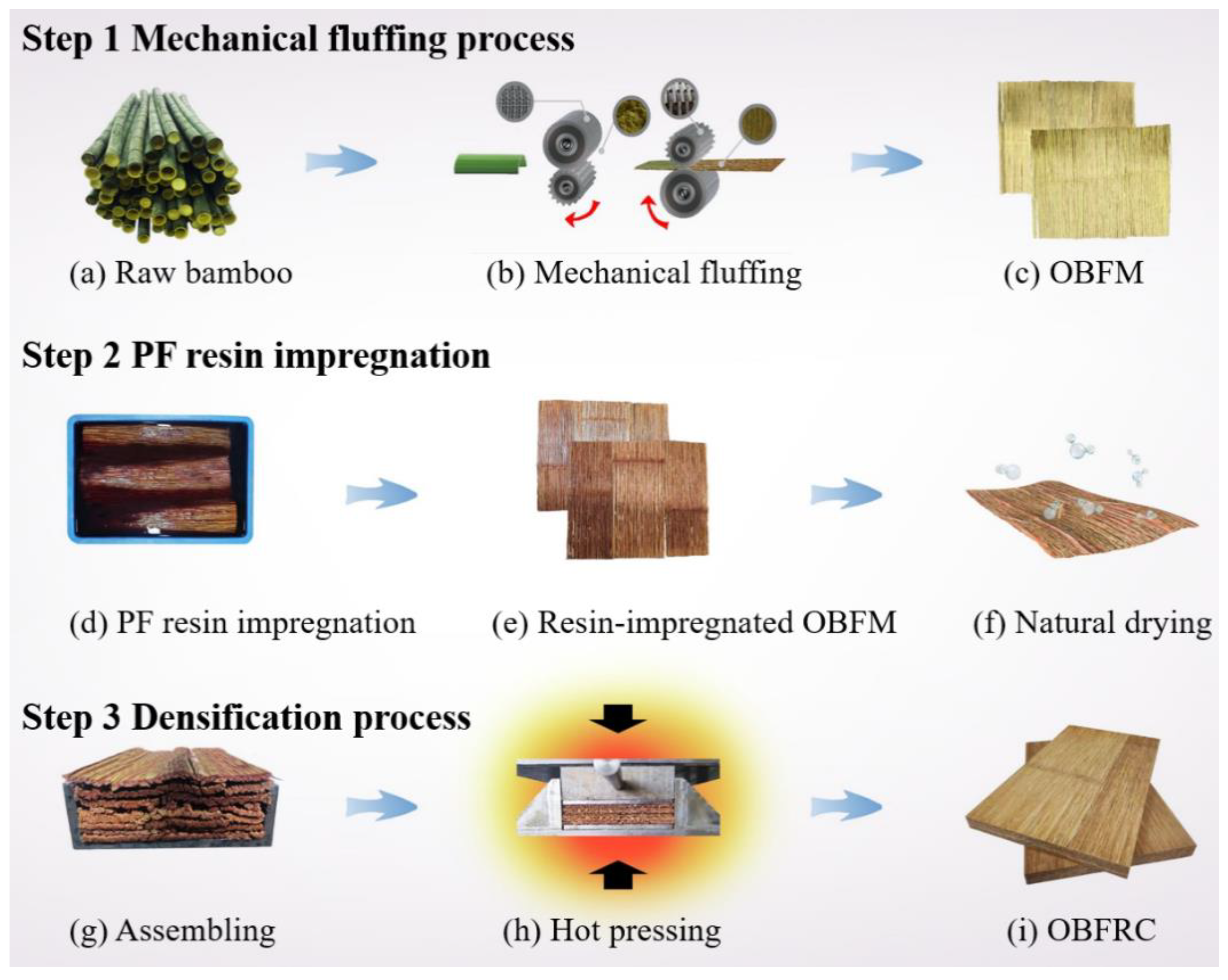
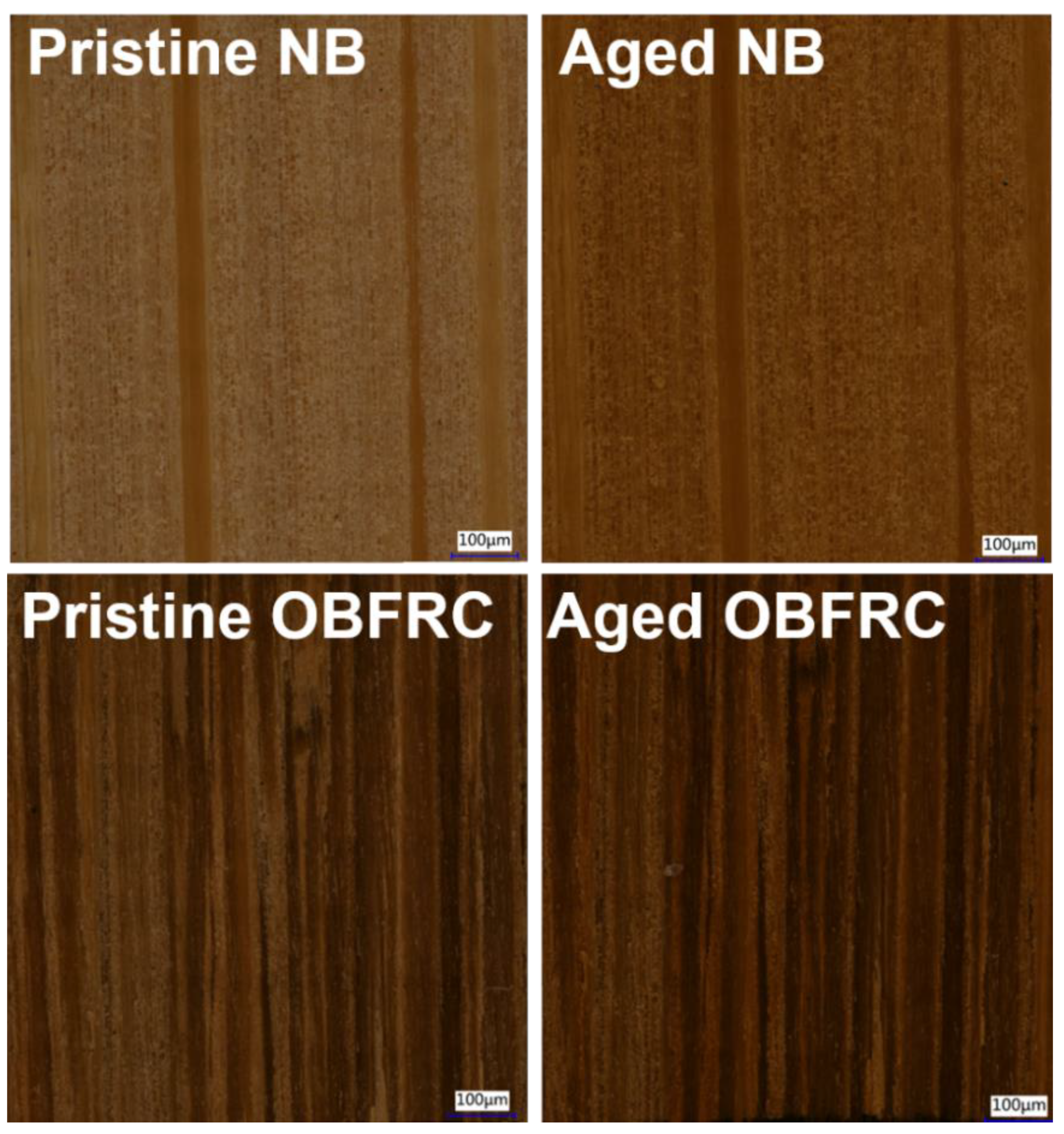
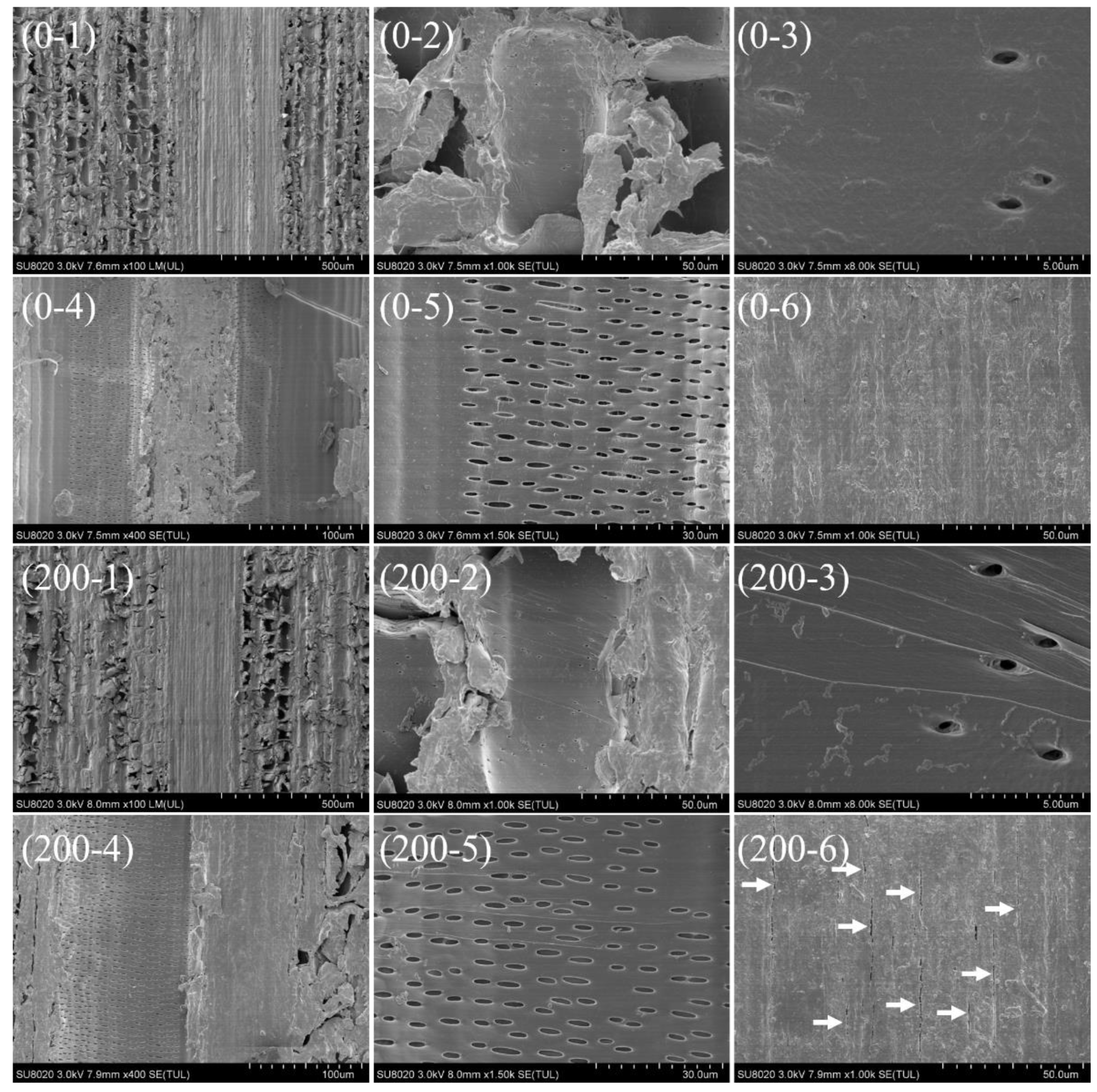

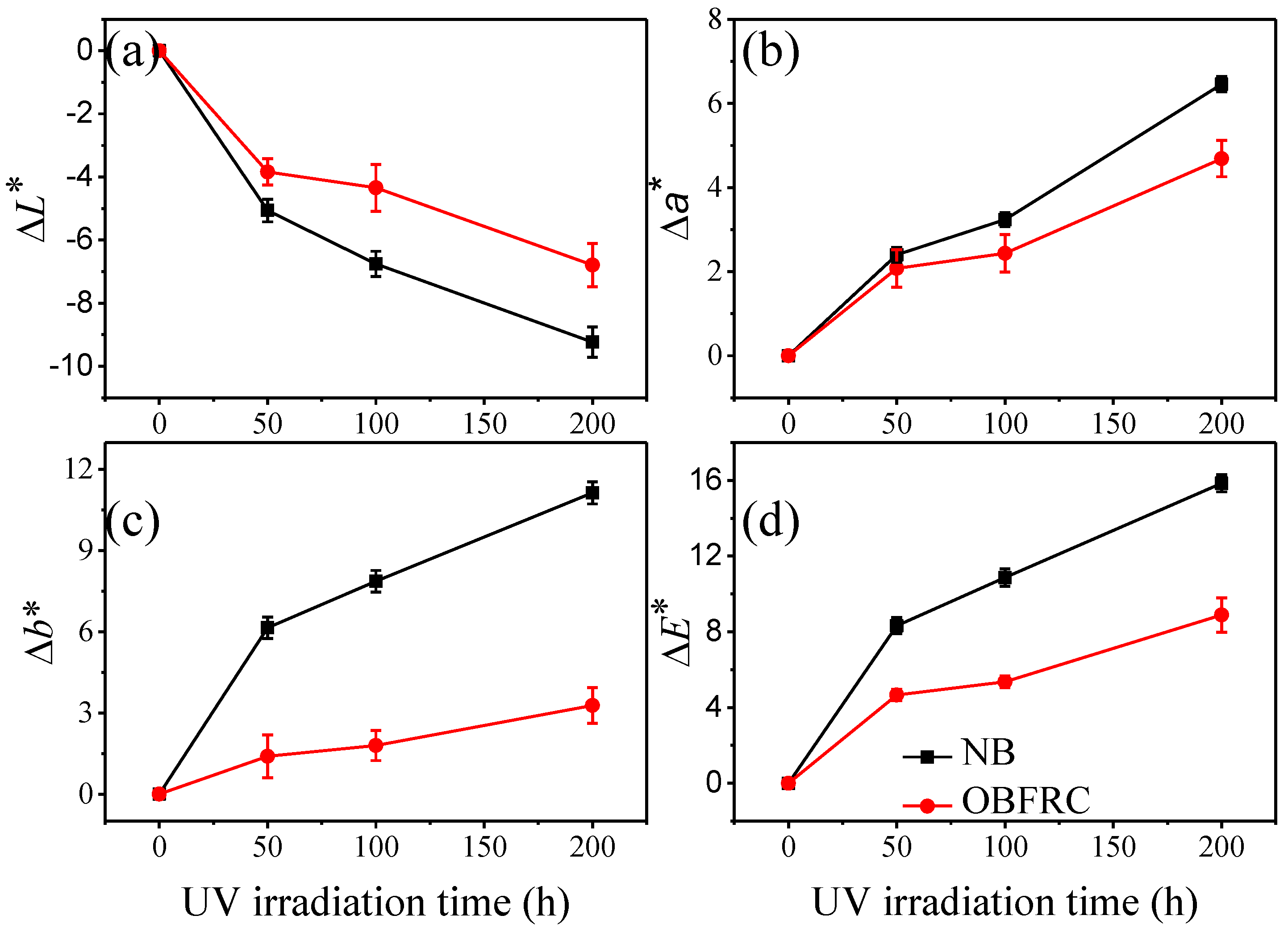
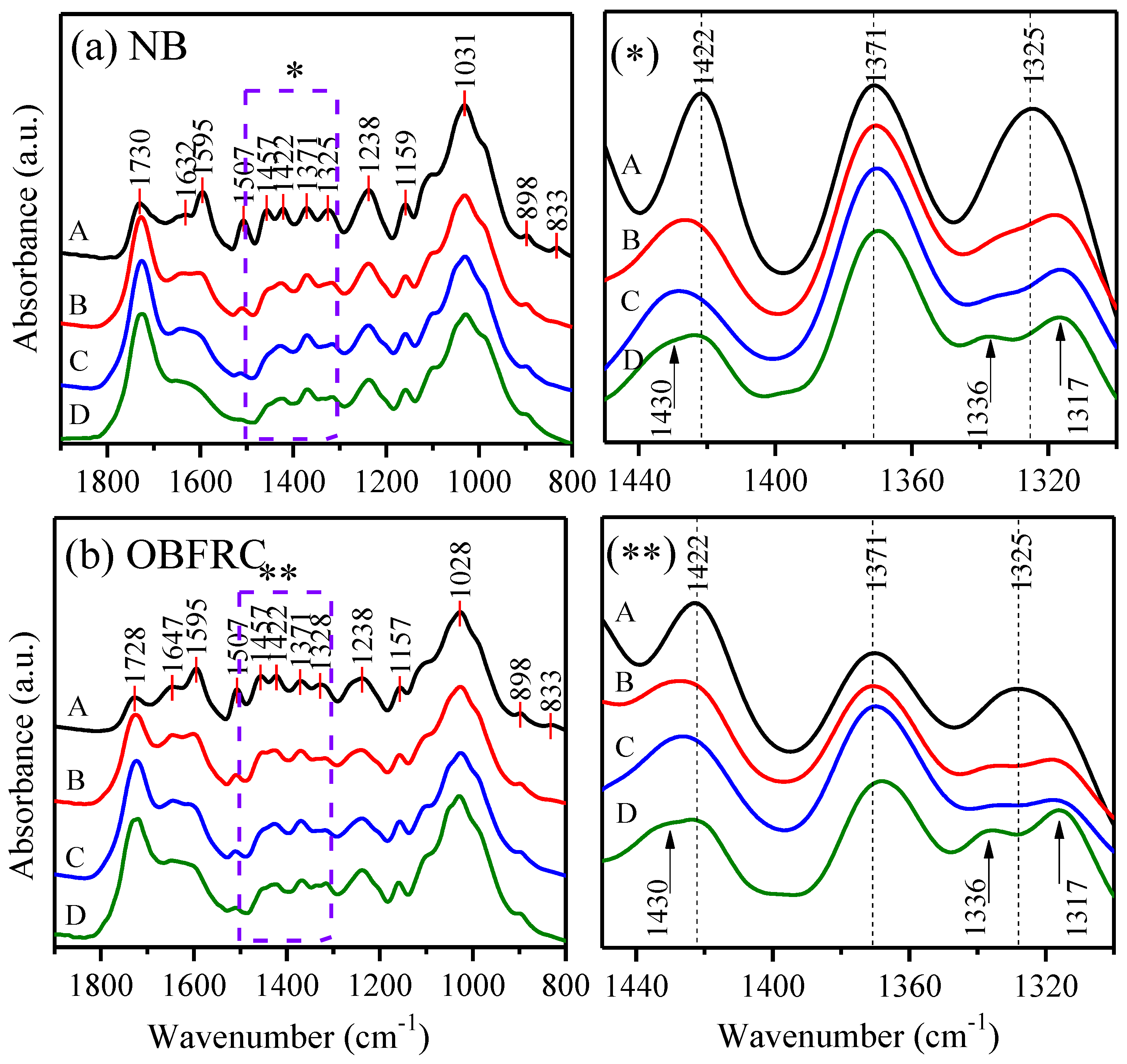
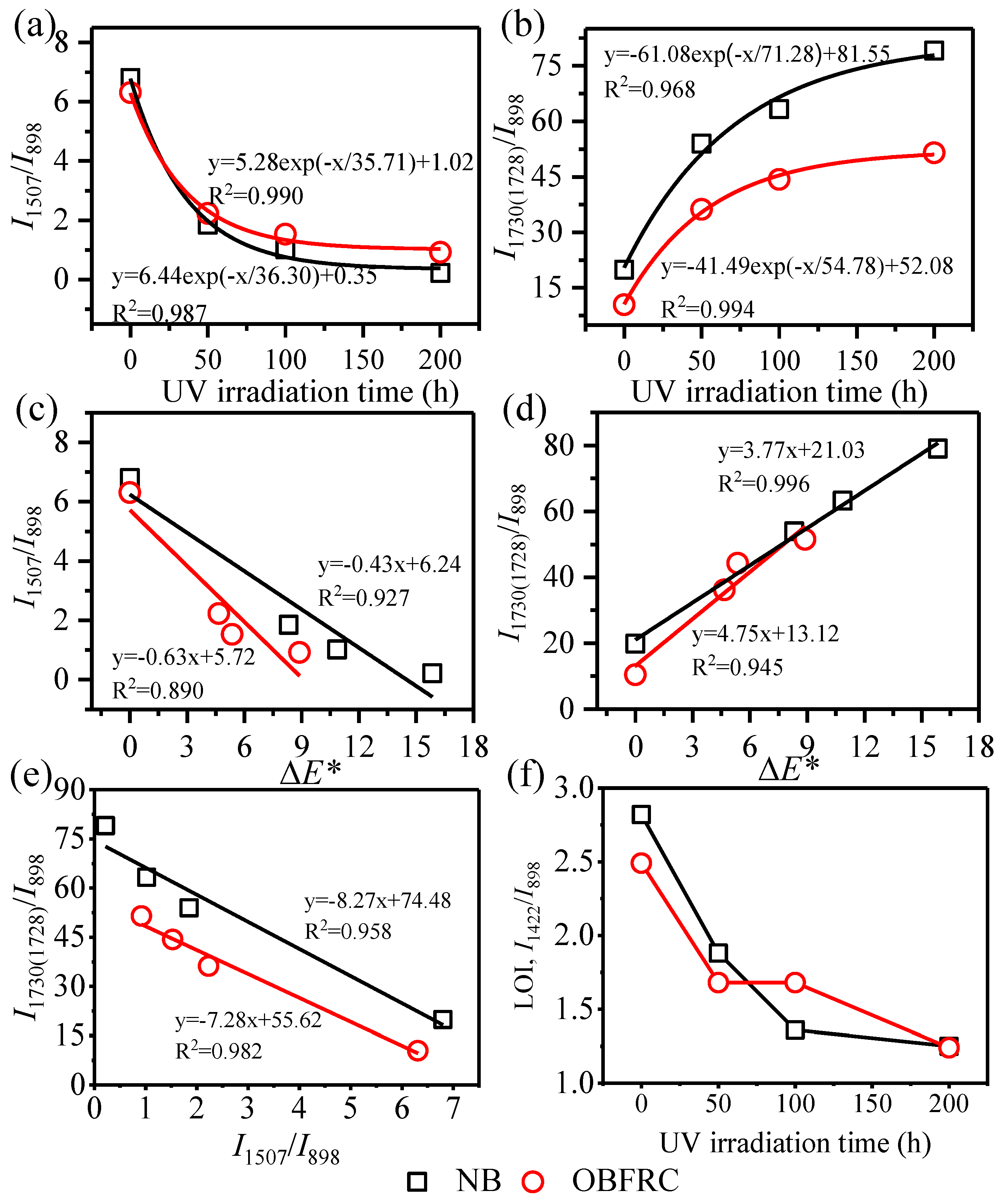
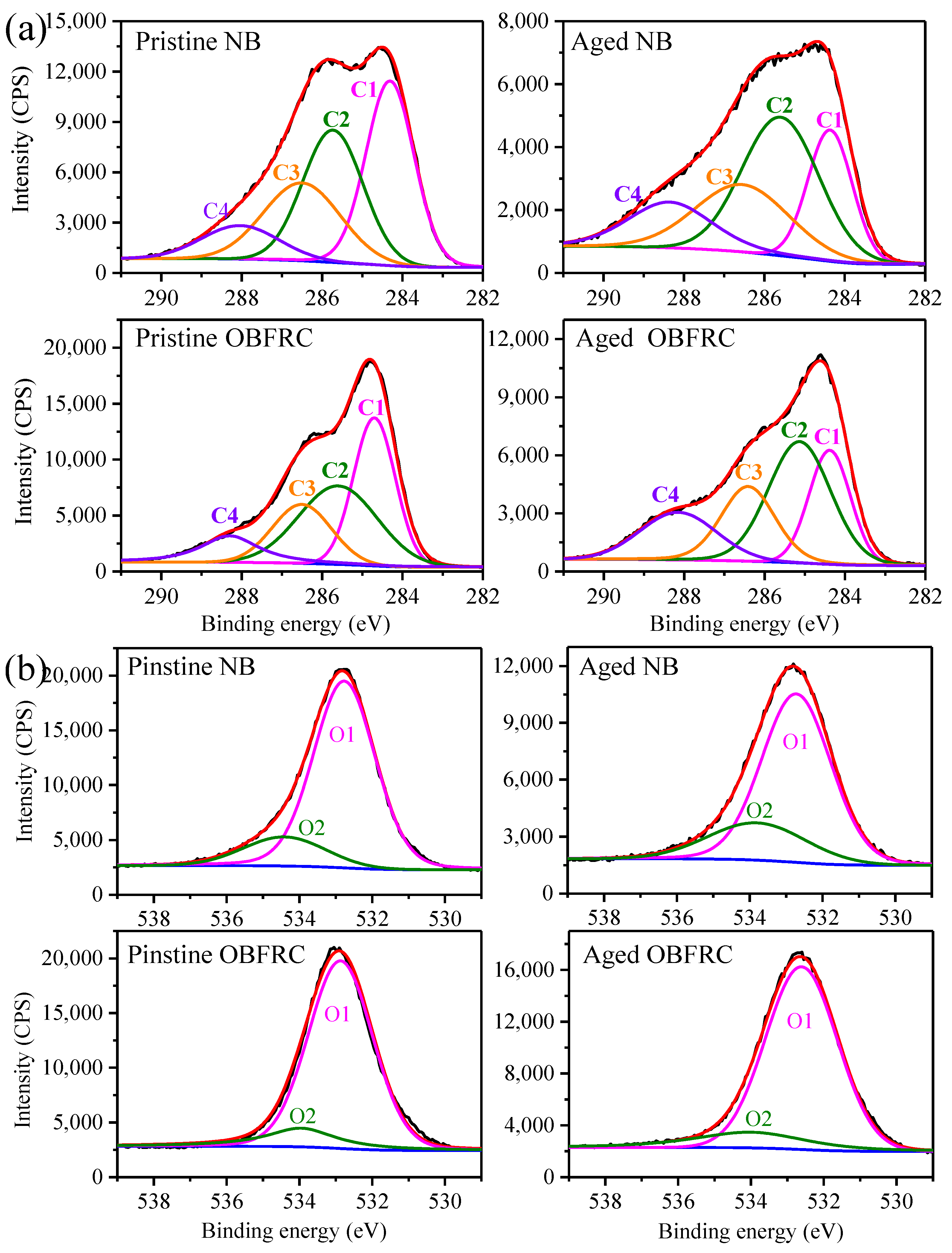
| Specimens | Pristine Specimens | Aged Specimens | ||||
|---|---|---|---|---|---|---|
| Ra | Rt | Rz | Ra | Rt | Rz | |
| NB | 2.0 (0.0) | 11.3 (1.4) | 18.3 (1.6) | 2.3 (0.5) | 16.0 (3.6) | 27.2 (7.4) |
| OBFRC | 2.0 (0.0) | 11.3 (0.5) | 15.3 (0.8) | 2.3 (0.5) | 11.8 (1.7) | 16.2 (2.3) |
| Wavenumber (cm−1) | Peak Assignment | |
|---|---|---|
| NB | OBFRC | |
| 1730 | 1728 | Non-conjugated C=O in hemicellulose (xylans) and formaldehyde (PF resin) |
| 1632 | 1647 | Conjugated C=O in lignin |
| 1595 | 1595 | C=C unsaturated linkages, aromatic skeletal vibration in lignin |
| 1507 | 1507 | Aromatic skeletal vibration (C=C) in lignin, stronger guaiacyl element than syringyl |
| 1457 | 1457 | C–H deformation in lignin, and O–H in plane deformation (cellulose) |
| 1422 | 1422 | Aromatic skeletal vibrations (lignin), CH2 bending vibrations in cellulose |
| 1371 | 1371 | C–H bending, –CH3 (lignin), –CH2 (carbohydrates), lignin carbohydrates complexes (LCC) bonds |
| 1325 | 1328 | Phenol group (cellulose) |
| 1336 | 1336 | O–H in plane bending (amorphous cellulose) |
| 1317 | 1317 | CH2 wagging (crystalline cellulose I) |
| 1238 | 1238 | Syringyl ring and C–O stretch in lignin and xylan |
| 1159 | 1157 | C–O–C vibration in cellulose and hemicellulose |
| 1031 | 1028 | Aromatic C–H in plane deformation, symmetrical C–O stretching |
| 898 | 898 | C–H deformation in cellulose |
| 833 | 833 | C–H deformation in Guaiacyl units (lignin) |
| Element Component | Binding Energy (eV) | Binding Type | Main Resources | |
|---|---|---|---|---|
| NB | PF Resin | |||
| C | ||||
| C1 | 284.5 | C–C, C–H | Lignin, fatty acids and other extracts | Benzene ring or methylene bond |
| C2 | 285.5 | C–O | Cellulose and hemicellulose | Hydroxymethyl and phenolic hydroxyl attached to benzene ring |
| C3 | 286.5 | O–C–O, C=O | Cellulose and hemicellulose | Active intermediate methylene quinone and methylene ether bond |
| C4 | 288.3 | O–C=O | Hemicellulose and extracts | - |
| O | ||||
| O1 | 532.8 | C=O | Lignin | Methylene quinone |
| O2 | 534.1 | C–O | Cellulose and hemicellulose | Hydroxymethyl bond |
| Element Component | Pristine NB | Aged NB | Pristine OBFRC | Aged OBFRC |
|---|---|---|---|---|
| C | 73.72 | 71.84 | 75.58 | 68.95 |
| C1 (%) | 31.03 | 18.04 | 32.04 | 21.54 |
| C2 (%) | 29.74 | 35.79 | 34.24 | 35.42 |
| C3 (%) | 25.40 | 26.59 | 20.53 | 22.60 |
| C4 (%) | 13.83 | 19.59 | 13.19 | 20.44 |
| C1/C2 | 1.04 | 0.50 | 0.94 | 0.61 |
| Cox/Cunox | 2.22 | 4.54 | 2.12 | 3.64 |
| A/B | 0.77 | 1.24 | 0.90 | 1.27 |
| O | 26.28 | 28.16 | 24.42 | 31.05 |
| O1 (%) | 79.68 | 72.57 | 86.67 | 85.38 |
| O2 (%) | 20.32 | 27.43 | 13.32 | 14.62 |
| O1/O2 | 3.92 | 2.65 | 15.38 | 5.84 |
| O/C | 0.36 | 0.39 | 0.32 | 0.45 |
Publisher’s Note: MDPI stays neutral with regard to jurisdictional claims in published maps and institutional affiliations. |
© 2021 by the authors. Licensee MDPI, Basel, Switzerland. This article is an open access article distributed under the terms and conditions of the Creative Commons Attribution (CC BY) license (https://creativecommons.org/licenses/by/4.0/).
Share and Cite
Rao, F.; Ji, Y.; Yang, Y.; Zhang, Y.; Li, N.; Yu, W.; Chen, Y. Rapid Process Natural Bamboo into Outdoor Bamboo-Fiber-Reinforced Composite with High Surface Photostability. Forests 2021, 12, 446. https://doi.org/10.3390/f12040446
Rao F, Ji Y, Yang Y, Zhang Y, Li N, Yu W, Chen Y. Rapid Process Natural Bamboo into Outdoor Bamboo-Fiber-Reinforced Composite with High Surface Photostability. Forests. 2021; 12(4):446. https://doi.org/10.3390/f12040446
Chicago/Turabian StyleRao, Fei, Yaohui Ji, Yang Yang, Yahui Zhang, Neng Li, Wenji Yu, and Yuhe Chen. 2021. "Rapid Process Natural Bamboo into Outdoor Bamboo-Fiber-Reinforced Composite with High Surface Photostability" Forests 12, no. 4: 446. https://doi.org/10.3390/f12040446
APA StyleRao, F., Ji, Y., Yang, Y., Zhang, Y., Li, N., Yu, W., & Chen, Y. (2021). Rapid Process Natural Bamboo into Outdoor Bamboo-Fiber-Reinforced Composite with High Surface Photostability. Forests, 12(4), 446. https://doi.org/10.3390/f12040446






